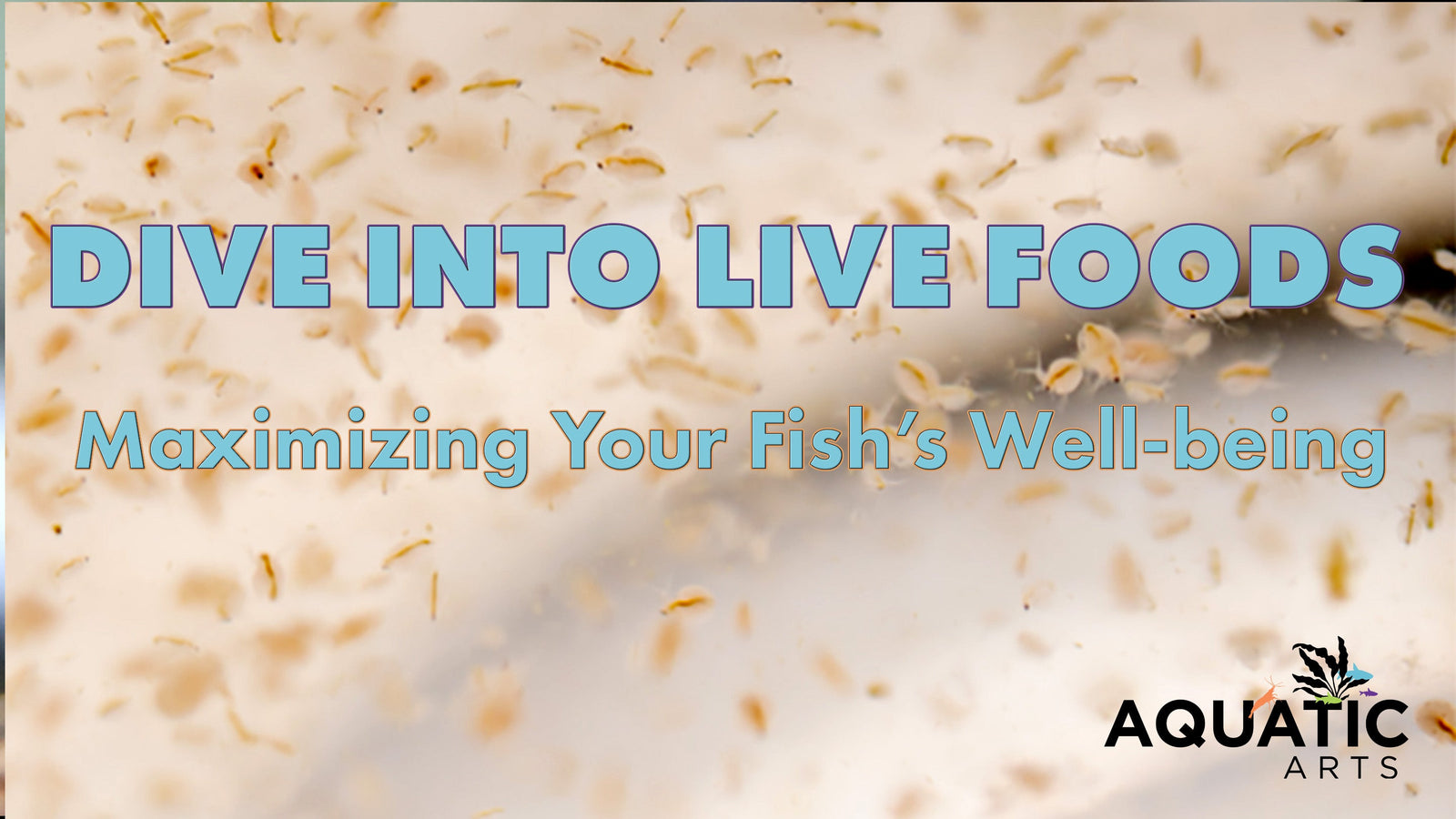
Dive into Live Foods: Maximizing Your Fish's Nutrition and Well-being
Elevate Your Aquarium's Diet with Live Foods
Feeding your freshwater aquarium fish a variety of foods is key to their health, growth, and overall well-being. While flakes and pellets are convenient, incorporating live foods can significantly enhance the vitality and color of your fish. This article introduces seven fantastic live foods: Moina macrocopa, Daphnia magna, Scuds (Gammarus sp.), Microworms, Tubifex Worms, Vinegar Eels, and Bladder Snails. We’ll explore their benefits, how to use them, how to keep them alive, and how to avoid common mistakes when culturing or feeding them.
Moina Macrocopa (Water Flea)

What Are Moina Macrocopa?
Moina macrocopa, commonly known as water fleas, are tiny crustaceans that are excellent live food for your aquarium fish. These creatures are slightly smaller than their cousin Daphnia, making them suitable for smaller fish and fry.
Benefits for Your Fish
- Nutrition: Rich in proteins and lipids, Moina provide essential nutrients that boost the immune system and enhance growth.
- Natural Behavior: Hunting live prey encourages natural hunting behaviors in fish, reducing stress and increasing activity levels.
- Clearer Water: Moina also consume microscopic algae and bacteria, helping to keep your aquarium clean.
Ideal Fish for Moina
Fish that benefit from Moina include bettas, guppies, tetras, and small cichlids. Fry, in particular, thrive on this easily digestible food source.
Keeping Moina Alive
To keep Moina alive, maintain them in a separate container with clean, aerated water. Feed them yeast or spirulina powder. Adding botanicals like almond leaves can provide extra nutrients and a habitat for microorganisms that Moina feed on. They reproduce quickly, so you can establish a sustainable culture with minimal effort.
Daphnia Magna (Water Flea)

What Are Daphnia Magna?
Daphnia magna, another type of water flea, are slightly larger than Moina. They are a popular choice among aquarists for their nutritional value and ease of culture.
Benefits for Your Fish
- Nutritional Value: High in protein, vitamins, and minerals, Daphnia promote vibrant colors and robust health.
- Digestive Aid: The exoskeleton of Daphnia aids in digestion, preventing constipation and other digestive issues.
- Stimulation: Chasing live Daphnia stimulates your fish’s natural hunting instincts, reducing boredom.
Ideal Fish for Daphnia
Angelfish, barbs, mollies, and goldfish are among the fish that enjoy Daphnia. These water fleas are also ideal for feeding juvenile fish.
Keeping Daphnia Alive
Daphnia thrive in well-aerated containers with green water (algae-rich water) or yeast solutions. Adding leaf litter, such as oak or beech leaves, can promote the growth of infusoria, a natural food source for Daphnia. Keep them at room temperature, and they will multiply, providing a steady food source for your aquarium.
Scud (Freshwater Amphipod)

What Are Scuds?
Scuds, or freshwater amphipods, are small, shrimp-like crustaceans. They are larger than Moina and Daphnia, making them suitable for medium to large fish.
Benefits for Your Fish
- High Protein: Scuds are packed with protein, making them an excellent choice for growth and muscle development.
- Enrichment: Chasing and catching scuds provides mental stimulation and physical exercise for your fish.
- Variety: Adding scuds to your fish's diet diversifies their nutrition, which is vital for their health.
Ideal Fish for Scuds
Cichlids, large tetras, gouramis, and many predatory fish like pufferfish benefit greatly from scuds. They are also a fantastic treat for larger fry.
Keeping Scuds Alive
Scuds are hardy and can be kept in a separate tank or container with aerated water and some vegetation or substrate to hide in. Using botanicals such as catappa leaves or alder cones can provide hiding places and contribute to the overall health of the scud environment. Feed them algae wafers or vegetable scraps, and they will thrive and reproduce.
Microworms (Panagrellus redivivus)

What Are Microworms?
Microworms are tiny nematodes, just visible to the naked eye, making them an excellent first food for fry and small fish species. Despite their name, they are not true worms but behave similarly and are highly nutritious.
Benefits for Your Fish
-
Perfect for Fry: Their small size makes them ideal for newborn fish that can’t eat larger live foods.
-
Digestible Protein: Microworms offer a soft-bodied protein source, perfect for delicate digestive systems.
-
Easy to Harvest: They crawl up container walls, making them easy to scoop and feed.
Ideal Fish for Microworms
Fry of guppies, tetras, barbs, bettas, and rainbowfish do exceptionally well on microworms. Even adult nano fish like chili rasboras and celestial pearl danios may snack on them.
Keeping Microworms Alive
Microworms are cultured on a moist mix of oatmeal or mashed potatoes with yeast. They require little maintenance, reproduce quickly, and can be harvested daily for consistent feeding.
Tubifex Worms (Tubifex tubifex)
What Are Tubifex Worms?
Tubifex worms are thin, red aquatic worms known for their high protein content. They’re excellent for larger fish and conditioning breeders.
Benefits for Your Fish
-
High Protein: Excellent for rapid growth and recovery.
-
Stimulates Appetite: Writhing movement triggers a strong feeding response.
-
Breeding Prep: Ideal for conditioning fish for spawning.
Keeping Tubifex Worms Alive
Store in shallow dechlorinated water, rinsing daily. For long-term culture, use fine substrate and light flow. Source from clean, parasite-free suppliers only.
Vinegar Eels (Turbatrix aceti)
What Are Vinegar Eels?
Vinegar eels are microscopic nematodes that thrive in unpasteurized apple cider vinegar. They are a great early live food for fry.
Benefits for Your Fish
-
Tiny Size: Ideal for fish that are too small to eat anything else.
-
Extended Survival: They live longer in freshwater than many other live foods.
-
Natural Movement: Their wriggling attracts feeding from hesitant fry.
Keeping Vinegar Eels Alive
Culture them in a mixture of apple cider vinegar and a few apple slices. Harvest by filtering through cotton or a coffee filter to rinse them before feeding.
Bladder Snails (Physella sp.)

What Are Bladder Snails?
Bladder snails are small, prolific snails that reproduce quickly in freshwater aquariums. While often seen as pests, they are an excellent live food for certain fish.
Benefits for Your Fish
-
Natural Prey: Crayfish, puffers, loaches, and many cichlids love snails.
-
Shell Calcium: Great for species that need added calcium in their diet.
-
Sustainable: Easy to breed and harvest from a separate tank.
Keeping Bladder Snails Alive
They’ll thrive in a planted aquarium or holding tank. Feed with algae wafers, leftover fish food, or blanched vegetables. Maintain water quality and remove extra snails as needed.
Comparison of Live Foods
| Live Food | Best For | Nutritional Value | Behavioral Benefit | Ease of Culture |
|---|---|---|---|---|
| Moina Macrocopa | Small fish, fry | High protein/lipids | Encourages hunting | Easy, fast-reproducing |
| Daphnia Magna | Small to Medium fish, juveniles | High protein, vitamins, aids digestion | Stimulates hunting | Easy, needs green water |
| Scuds | Medium-large fish, predators | High protein, muscle development | Active foraging and chasing | Hardy, needs hiding spots |
| Microworms | Fry, nano fish | Soft-bodied protein, easy digestion | Ideal for small mouths, motion triggers feeding | Very easy, harvest daily |
| Tubifex Worms | Bottom-dwellers, breeders | Very high in protein and iron | Strong feeding response | Moderate, requires clean water |
| Vinegar Eels | Newborn fry | Tiny size, decent protein | Constant movement in water | Very easy, vinegar-based |
| Bladder Snails | Puffers, loaches, crayfish | Protein, calcium-rich shell | Cracking and chasing snails | Self-replicating in tanks |
Size and Suitability
- Moina Macrocopa: Best for small fish and fry due to their tiny size. Ideal for bettas, guppies, and small tetras.
- Daphnia Magna: Larger than Moina, suitable for medium-sized fish like angelfish, barbs, and mollies.
- Scuds: Largest of the three, perfect for medium to large fish such as cichlids, large tetras, and gouramis.
Nutritional Content
- Moina Macrocopa: High in proteins and lipids, excellent for growth and immune support.
- Daphnia Magna: High in protein, vitamins, and minerals, aids in digestion.
- Scuds: Very high in protein, promotes muscle development and overall health.
Behavioral Benefits
- Moina Macrocopa: Encourages natural hunting behavior, reducing stress.
- Daphnia Magna: Stimulates hunting instincts, preventing boredom.
- Scuds: Provides mental and physical enrichment through active chasing and catching.
Ease of Culturing
- Moina Macrocopa: Easy to culture with minimal effort; reproduce quickly.
- Daphnia Magna: Also easy to culture, requiring green water or yeast solutions.
- Scuds: Hardy and easy to maintain, thrive on algae wafers and vegetable scraps.
Avoiding Common Mistakes That Kill Live Foods
Moina macrocopa (Water Fleas)
-
Avoid overfeeding with yeast or spirulina: Excess nutrients can cause bacterial blooms that deplete oxygen, crash your culture, and make the water foul-smelling and lethal.
-
Keep water clean and well-aerated: Moina are filter feeders that thrive in oxygen-rich environments. Good aeration improves reproduction and keeps the water column from becoming stagnant.
-
Avoid temperature swings: Moina are temperature-sensitive. Fluctuations can reduce reproduction rates and increase mortality, especially in small cultures without thermal stability.
Daphnia magna (Water Fleas)
-
Provide enough aeration: Daphnia need suspended food particles to feed. Gentle bubbling keeps food like algae or yeast in motion and maintains high oxygen levels.
-
Harvest regularly to prevent overcrowding: Overcrowding depletes oxygen and food while encouraging waste buildup, leading to mass die-offs. Harvesting also promotes consistent reproduction.
-
Don’t introduce soaps or chemicals: Even trace amounts of detergents or cleaners are lethal. Use culture-dedicated tools and rinse containers thoroughly before reuse.
Scuds (Gammarus sp.)
-
Maintain a steady supply of food and shelter: Without decaying plant matter, algae wafers, or biofilm, scuds will starve. Botanicals and substrate provide security, helping them breed and hide from each other.
-
Avoid predators in the culture tank: Even small fish can decimate a scud population overnight. If culturing, keep them in a separate, fish-free environment.
-
Perform regular water changes: Scuds produce waste quickly in small setups. Water changes prevent ammonia spikes and keep tannin levels balanced for biofilm health.
Microworms (Panagrellus redivivus)
-
Prevent mold by keeping cultures clean: Mold competes with worms for oxygen and food and can quickly overtake a culture. Use clean tools and avoid overfeeding yeast.
-
Keep cultures moist—not too wet or dry: A balanced texture keeps the worms crawling to the surface without drowning or drying out. The goal is a damp, paste-like consistency.
-
Refresh cultures every few weeks: Older cultures decline in productivity. Starting a new batch from a healthy portion keeps your supply reliable and prevents total loss.
Tubifex Worms (Tubifex tubifex)
-
Rinse daily in clean, cool water: Tubifex release waste rapidly. Rinsing removes toxins and prevents self-contamination in the holding container.
-
Source from parasite-free environments: Wild or poorly maintained sources may carry harmful pathogens. Always quarantine and verify the origin of your worms.
-
Avoid fouling the tank with uneaten worms: Tubifex burrow into substrate and may die unseen. Feed sparingly and remove leftovers to prevent anaerobic decay.
Vinegar Eels (Turbatrix aceti)
-
Use unpasteurized vinegar: Live cultures require natural bacterial activity to thrive. Filtered or pasteurized vinegar lacks the microbial base needed to support eel reproduction.
-
Don’t overcrowd or let the culture dry: A balanced eel population prevents oxygen depletion. Maintain fluid levels and add new apple slices every few weeks for nourishment.
-
Strain well before feeding: Vinegar lowers tank pH. Rinse eels with freshwater using coffee filters or cotton to avoid adding acidity to your fry tanks.
Bladder Snails (Physella sp.)
-
Don’t let populations explode: While great feeders, unchecked snail populations can overrun your tanks. Overstocked tanks lead to oxygen depletion and high bioloads.
-
Harvest regularly for feeding: Routine harvesting keeps colonies under control and ensures you have snails of various sizes for different fish.
-
Feed lightly to avoid fouling culture tanks: Snails produce waste quickly, especially when overfed. A small piece of blanched veggie or algae wafer every few days is plenty.
Q&A Section
What are the benefits of feeding live foods to my freshwater fish?
Live foods provide superior nutrition, promote natural hunting behaviors, reduce stress, and enhance fish coloration and health.
Can I culture Moina macrocopa at home?
Yes, Moina macrocopa are easy to culture at home. Maintain them in a clean, aerated container, and feed them yeast or spirulina powder.
What type of fish benefits from Daphnia magna?
Medium-sized fish like angelfish, barbs, mollies, and goldfish benefit from the nutritional value and stimulation provided by Daphnia magna.
How do I keep scuds alive?
Scuds can be kept in a separate tank with aerated water and some vegetation or substrate to hide in. Feed them algae wafers or vegetable scraps and use botanicals like catappa leaves to enhance their environment.
Are there any special requirements for maintaining these live foods?
Each live food has its own specific needs. Moina macrocopa and Daphnia magna thrive with regular feeding of yeast or algae solutions, while scuds require a more substantial diet and hiding spaces provided by vegetation or botanicals.
Can I use leaf litter in my live food cultures?
Yes, leaf litter such as almond leaves, oak leaves, and catappa leaves can provide additional nutrients and hiding places, promoting a healthier environment for live foods like Moina, Daphnia, and scuds.
How do I avoid killing my live foods?
To avoid killing your live foods, maintain good water quality, provide adequate aeration, avoid overfeeding, and ensure a stable environment with proper hiding places and food supply.
Conclusion
Incorporating live foods such as Moina macrocopa, Daphnia magna, and scuds into your freshwater aquarium can significantly enhance the health, growth, and natural behavior of your fish. These live foods offer superior nutrition and encourage active foraging, keeping your fish lively and vibrant.
By setting up small cultures of these live foods and using botanicals or leaf litter, you ensure a continuous, fresh supply for your aquarium. Whether you have small fry or large predatory fish, these live foods can make a notable difference in their diet. Try introducing these live foods to your aquarium, and watch your fish thrive!
Visit our full menu of live food options by clicking this link




